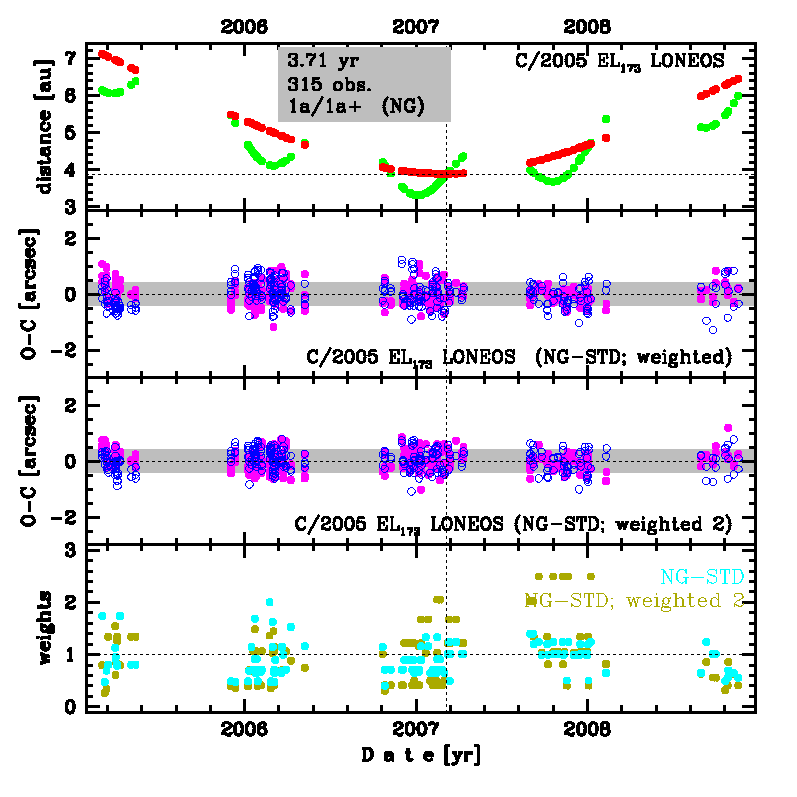C/2005 EL173 LONEOS
more info
C/2005 EL173 was discovered on 8 March 2005 by the LONEOS as an apparently asteroidal object in a retrograde orbit and semimajor axis of 36 au [MPEC 2005-F48, 2005 March 29]. Therefore it was initially classified as cubewano or scattered disc object in MPC. Its cometary apperance was reported by A. Fitzsimmons on 10 May 2005. C/2005 EL173 was observed until mid-November 2008.
This comet made its closest approach to the Earth on 4 January 2007 (3.310 au), two months before perihelion passage.
Solutions given here are based on data spanning over 3.7 yr in a range of heliocentric distances: 7.12 au – 3.886 au (perihelion) – 6.45 au.
NG orbit using full data-arc is determinable.
This Oort spike comet suffers rather slight planetary perturbations during its passage through the planetary system; however, these perturbations leas to escape this comet from the planetary zone on a hyperbolic orbit.
See also Królikowska and Dones 2023, Królikowska and Dybczyński 2017,and Królikowska 2014.
This comet made its closest approach to the Earth on 4 January 2007 (3.310 au), two months before perihelion passage.
Solutions given here are based on data spanning over 3.7 yr in a range of heliocentric distances: 7.12 au – 3.886 au (perihelion) – 6.45 au.
NG orbit using full data-arc is determinable.
This Oort spike comet suffers rather slight planetary perturbations during its passage through the planetary system; however, these perturbations leas to escape this comet from the planetary zone on a hyperbolic orbit.
See also Królikowska and Dones 2023, Królikowska and Dybczyński 2017,and Królikowska 2014.
| solution description | ||
|---|---|---|
| number of observations | 317 | |
| data interval | 2005 03 03 – 2008 11 17 | |
| data type | perihelion within the observation arc (FULL) | |
| data arc selection | entire data set (STD) | |
| range of heliocentric distances | 7.12 au – 3.89 au (perihelion) – 6.45 au | |
| type of model of motion | NS - non-gravitational orbits for standard g(r) | |
| data weighting | YES | |
| number of residuals | 632 | |
| RMS [arcseconds] | 0.36 | |
| orbit quality class | 1a+ | |
| previous orbit statistics, both Galactic and stellar perturbations were taken into account | ||
|---|---|---|
| no. of returning VCs in the swarm | 5001 | * |
| no. of escaping VCs in the swarm | 0 | |
| no. of hyperbolas among escaping VCs in the swarm | 0 | |
| previous reciprocal semi-major axis [10-6 au-1] | 45.24 – 46.94 – 48.67 | |
| previous perihelion distance [au] | 190 – 220 – 260 | |
| previous aphelion distance [103 au] | 40.9 – 42.4 – 43.9 | |
| time interval to previous perihelion [Myr] | 3.24 – 3.39 – 3.55 | |
| percentage of VCs with qprev > 20 | 100 | |

Upper panel: Time distribution of positional observations with corresponding heliocentric (red curve) and geocentric (green curve) distance at which they were taken. The horizontal dotted line shows the perihelion distance for a given comet whereas vertical dotted line — the moment of perihelion passage.
Middle panel(s): O-C diagram for a given solution (sometimes in comparison to another solution available in CODE), where residuals in right ascension are shown using magenta dots and in declination by blue open circles.
Lowest panel: Relative weights for a given data set(s).
Middle panel(s): O-C diagram for a given solution (sometimes in comparison to another solution available in CODE), where residuals in right ascension are shown using magenta dots and in declination by blue open circles.
Lowest panel: Relative weights for a given data set(s).
| previous_g orbit statistics, here only the Galactic tide has been included | ||
|---|---|---|
| no. of returning VCs in the swarm | 5001 | * |
| no. of escaping VCs in the swarm | 0 | |
| no. of hyperbolas among escaping VCs in the swarm | 0 | |
| previous reciprocal semi-major axis [10-6 au-1] | 43.52 – 44.79 – 46.05 | |
| previous perihelion distance [au] | 8.01 – 8.53 – 9.14 | |
| previous aphelion distance [103 au] | 43.4 – 44.6 – 45.9 | |
| time interval to previous perihelion [Myr] | 3.19 – 3.33 – 3.47 | |
| percentage of VCs with qprev < 10 | 100 | |